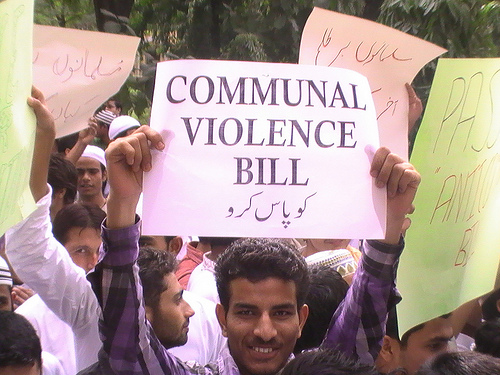
Courtesy: saddahaq.com
It is often said that India is afflicted by three Cs, all in capital letters: Casteism, Communalism, Corruption. The issue of corruption and Team Anna’s own peculiar recipe to deal with it have so hogged the headlines through most of 2011 that insufficient attention has been paid to another bill on the anvil – the Communal and Targeted Violence Bill – which addresses the other two Cs. In May this year the Sonia Gandhi-headed National Advisory Council (NAC) placed its draft Prevention of Communal and Targeted Violence Bill 2011 in the public domain, inviting comments from the public. The draft bill now awaits the consent of the union cabinet before it can be tabled in Parliament. Meanwhile, the sharpest attacks, the loudest howls of protest against the proposed law have come from the BJP, other constituents of the sangh parivar and their political allies. The fact that communal organisations are so vehemently opposed to the proposed law indicates that something must be very right with what has been suggested.
It is true that some misgivings have also been expressed vis-ŕ-vis certain provisions of the draft bill by some allies of the Congress and a few others from within secular quarters. The rationale behind the bill is the subject matter of our cover story this month, in which the misconceptions and apprehensions of some secularists have also been comprehensively dealt with. Our limited purpose here is to draw our readers’ attention to an issue that Communalism Combat has repeatedly focused on, more so since the genocidal targeting of Muslims by the Narendra Modi-led BJP government in Gujarat in 2002.
The issue in question is the culture of impunity in the context of communal or targeted violence, which has prevailed in the country since independence. Reports of various judicial commissions – appointed by different governments from time to time to probe incidents of communal violence, fix responsibilities and make recommendations – have two conclusions in common. One, the violence was not spontaneous but the result of meticulous planning, organisation and implementation by Hindu communal bodies. Two, the police and the administration displayed anti-minority bias. The repeated recommendations by commission after commission on what needs to be done to pre-empt violence and punish the police officers and administrators guilty of dereliction of duty have gone unheeded. It is in this climate of permissiveness and the absence of accountability mechanisms that the culture of impunity has flourished.
As lawyer HS Phoolka – who for over two decades has spearheaded the legal battle for justice for the victims of the anti-Sikh carnage in 1984 – has repeatedly stated in recent years, if the perpetrators of 1984 had been prosecuted and punished, the 1992-93 anti-Muslim pogrom in Mumbai may have been prevented; and if the perpetrators of 1992-93 had been punished, the 2002 genocide in Gujarat may have been pre-empted. Not only have the perpetrators and errant policemen and civil servants never been punished; in the last 25 years we have repeatedly seen the state playing the role of mute witness, co-conspirator or even sponsor of mass crimes whose targets have been the country’s religious and other minorities.
It is against this backdrop that civil society groups have been campaigning, since the 2002 killings, for an appropriate law to bring an end to this unconscionable and blatantly unconstitutional state of impunity. It was in response to this persistent campaign, in which Citizens for Justice and Peace and Communalism Combat were among the most vocal, that in 2005 the first UPA government floated a draft – The Communal Violence (Prevention, Control and Rehabilitation of Victims) Bill 2005 – for discussion and debate. The bill elicited widespread criticism from the very groups and organisations which had been at the forefront of demands for a new law. To them, it was evident that the bill as it stood then would be worthless in preventing future massacres. A principal demand was that the new law should hold public servants – politicians, senior civil servants and police officers – accountable for their failure to control targeted violence. If anything, the 2005 draft envisaged even greater powers for the police instead of holding them accountable. In the face of all-round criticism, the draft was reworked but even the second draft was far from satisfactory.
In a welcome move, soon after the UPA-II government took charge in 2009 and the NAC was revived on Sonia Gandhi’s initiative, the council included a Communal Violence Bill among its priorities. The bill of 2011 is a result of that initiative. We need only add here that since both the UPA-I and UPA-II governments had in principle accepted the need for such a bill, they now have an obligation to ensure that the new bill sails through Parliament notwithstanding the expected resistance from the BJP and its allies. For the UPA government to delay or procrastinate on the bill – simply because, unlike Team Anna, the NAC members have neither threatened indefinite hunger strike nor issued deadlines and ultimatums – would be unfortunate, to say the least.
– EDITORS
Archived from Communalism Combat, November 2011, Year 18, No.161- Editorial